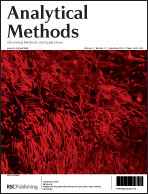The present work describes and discusses the possible interference problems in the voltammetric determination of ultra-trace concentrations of Hg(II) in the presence of Cu(II) at a gold electrode, using three different supporting electrolytes: 0.1 mol L−1 HClO4, 0.01 mol L−1 EDTA-Na2 + 0.06 mol L−1 NaCl + 2.0 mol L−1 HClO4 and 0.1 mol L−1 KSCN + 0.001 mol L−1 HClO4. The square wave anodic stripping voltammetric (SWASV) measurements were carried out using a conventional three-electrode cell, with a gold electrode (GE) as the working electrode, and platinum wire and Ag|AgCl|KClsat as auxiliary and reference electrodes, respectively. The analytical procedure was validated by the analysis of the standard reference materials Estuarine Sediment BCR-CRM 277, River Sediment BCR-CRM 320 and Mercury in Water NIST-SRM 1641d. In the presence of reciprocal interference, the standard addition method considerably improved the resolution of the voltammetric technique even in the case of very high concentration ratios of both metals. The analytical procedure was transferred and applied to sediments and sea waters sampled in a lagoon ecosystem connected to the Adriatic Sea and located in proximity to the Ravenna area (Italy).

You have access to this article
 Please wait while we load your content...
Something went wrong. Try again?
Please wait while we load your content...
Something went wrong. Try again?


 Please wait while we load your content...
Please wait while we load your content...